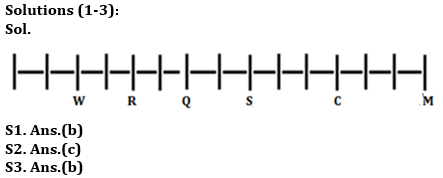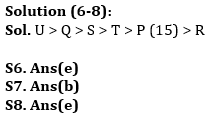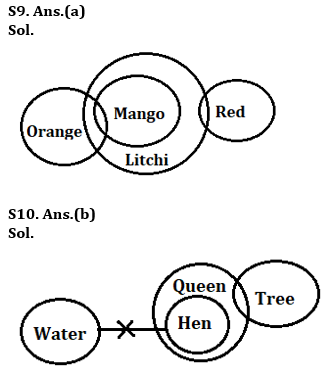Directions (1-3): Study the following information carefully and answer the questions given below.
There are some persons sitting in a row facing in north. Two persons sit between M and C. Four person sit between C and Q. R sits second to the left of Q. Six person sit to the left of Q. As many persons sit between C and M as sit between S and C. W sits third from one of extreme ends of the row but not an immediate neighbor of C. No one sits to the right of M.
Q1. If E sits between Q and S, then what is the position of M with respect to E?
(a) Fifth to the right
(b) Seventh to the right
(c) Fifth to the left
(d) Seventh to the left
(e) None of these
Q2. How many persons are sitting in the row?
(a) Twelfth
(b) Ten
(c) Fifteen
(d) Eleven
(e) None of these
Q3. What is the position of W with respect to R?
(a) Fifth to right
(b) Second to the left
(c) Fifth to the left
(d) Seventh to the left
(e) None of these
Q4. In a row of children facing in North, R is 12th from the right end and is 5th to the right of S who is 10th from the left end. Total how many children are there in the row?
(a) 29
(b) 28
(c) 26
(d) 27
(e) None of these
Q5. In a class of 36 students Preet’s rank from the top is 12. Radhika ranks three places above Preet. What is Radhika’s rank from bottom?
(a) 27
(b) 28
(c) 26
(d) 29
(e) None of these
Directions (6-8): Study the following information carefully and answer the questions given below.
Amongst Six persons P, Q R, S, T and U each one has different age. T’s age is more than P and R. Q is older than S. Only three persons are younger than S. P is not the youngest employee. The age second youngest is 15yrs. U is older than Q.
Q6. Who among the following is eldest?
(a) S
(b) Q
(c) R
(d) P
(e) None of these
Q7. How many persons older than T?
(a) One
(b) Three
(c) Two
(d) More than three
(e) None
Q8. If S’s age is 36 years than what may be the age of Q?
(a) 24yr
(b) 48yr
(c) 40yr
(d) 9yr
(e) Can’t be determined
Directions (9-10): In each of the questions below some statements are given followed by some Conclusions. You have to take the given statements to be true even, if they seem to be at variance from commonly known facts. Read all the conclusions and then decide which of the given conclusions logically follows from the given statements disregarding commonly known facts.
(a) If only conclusion I follows.
(b) If only conclusion II follows.
(c) If either conclusion I or II follows.
(d) If neither conclusion I nor II follows.
(e) If both conclusions I and II follow.
Q9. Statements:
Some Orange are Mango
All Mango are Litchi
Some litchi are Red
Conclusions:
I. Some litchi are Orange
II. Some Red are mango
Q10. Statements:
No water is hen
All hen are Queen
Some Queen are Tree
Conclusions:
I. Some tree are not water
II. Some queen are not water
Solutions

S4. Ans.(c)
Sol. S’s position from left end = 10th
S’s position from right end = 17th
Total number of children in the row = 10 + 17 – 1 = 26
S5. Ans.(b)
Sol. (36-9) + 1 = 28th from the bottom.







 GA Capsule for SBI Clerk Mains 2025, Dow...
GA Capsule for SBI Clerk Mains 2025, Dow...
 The Hindu Review October 2022: Download ...
The Hindu Review October 2022: Download ...
 RBI Grade B Interview Preparation Tips
RBI Grade B Interview Preparation Tips





